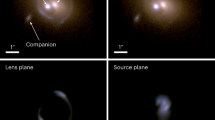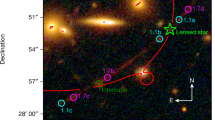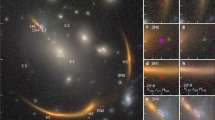Abstract
Even before the discovery of the first gravitational lens system1 in 1979 (see ref. 2 for a recent review of the other published candidates), it was recognized that a statistical evaluation of the occurrence of gravitational lensing within a well-defined sample of quasars is important to understand better the quasar luminosity function and possibly the QSO phenomenon itself3, to test cosmological models4,5 and to probe the luminous and dark matter distribution on various scales in the Universe4–6. A year ago, we began a systematic search from the European Southern Observatory (ESO) at La Silla, Chile, for gravitational lens systems in a selected sample of highly luminous quasars; Mv<–29.0. These objects are promising candidates for gravitationally lensed QSO images with arc-second and sub-arc-second separations (J.S. et al., manuscript in preparation and refs 7 and 8). Since December 1986, we have identified four possible cases. Here we give a brief description of our first identified gravitational lens system UM673 = Q0142–100 =PHL37039–11. It consists of two images, A (mR = 16.9) and B (mR = 19.1), separated by 2.2arcs at a redshift zq = 2.719. The lensing galaxy (mR≈ 19, ZL≈0.49) has also been found. It lies very near the line connecting the two QSO images, ˜0.8 arc s from the fainter one. Application of gravitational optometry to this system leads to a value M0≈2.4×1011M⊙ for the mass of the lensing galaxy and to δt≈7 weeks for the most likely travel-time difference between the two light paths to the QSO (assuming H0= 75 km s–1 Mpc–1,q0 = 0).
This is a preview of subscription content, access via your institution
Access options
Subscribe to this journal
Receive 51 print issues and online access
$199.00 per year
only $3.90 per issue
Buy this article
- Purchase on Springer Link
- Instant access to full article PDF
Prices may be subject to local taxes which are calculated during checkout
Similar content being viewed by others
References
Walsh, D., Carswell, R. F. & Weymann, R. J. Nature 279, 381–384 (1979).
Canizares, C. R. in IAU Symp. 124: Observational Cosmology (eds Hewitt, A., Burbidge, G. & Fang, L. Z.) 729–744 (Reidel, Amsterdam, 1987).
Barnothy, J. M. & Barnothy, M. F. Science 162, 348–352 (1968).
Refsdal, S. Mon. Not. R. astr. Soc. 128, 307–310 (1964).
Refsdal, S. Mon. Not. R. astr. Soc. 132, 101–111 (1966).
Canizares, C. R. Nature 291, 620–624 (1981); erratum Nature 293, 490 (1981).
Turner, E. L., Ostriker, J. P. & Gott, J. R. III Astrophys. J. 284, 1–22 (1984).
Ostriker, J. P. & Vietri, M. Astrophys. J. 300, 68–76 (1986).
MacAlpine, G. M. & Feldman, F. R. Astrophys. J. 261, 412–421 (1982).
Berger, J. & Fringant, A.-M. Astr. Astrophys. Suppl. 61, 191–202 (1985).
Véron-Cetty, M.-P. & Véron, P. European Southern Observatory Scient. Rep. no. 5 (1987).
Dekker, H. & D'Odorico, S. European Southern Observatory Operating Manual no. 4 (1985).
West, R. M. & Kruszewski, A. Irish astr. J. 15, 25–35 (1981).
Coleman, G. D., Wu, C.-C. & Weedman, D. W. Astrophys. J. Suppl. Ser. 43, 393–416 (1980).
Borgeest, U. & Refsdal, S. Astr. Astrophys. 141, 318–322 (1984).
Borgeest, U. Astrophys. J. 309, 467–471 (1986).
Author information
Authors and Affiliations
Rights and permissions
About this article
Cite this article
Surdej, J., Magain, P., Swings, JP. et al. A new case of gravitational lensing. Nature 329, 695–696 (1987). https://doi.org/10.1038/329695a0
Received:
Accepted:
Issue Date:
DOI: https://doi.org/10.1038/329695a0
Comments
By submitting a comment you agree to abide by our Terms and Community Guidelines. If you find something abusive or that does not comply with our terms or guidelines please flag it as inappropriate.



